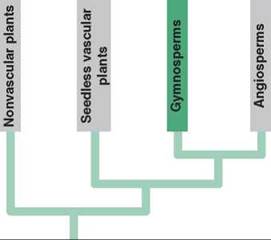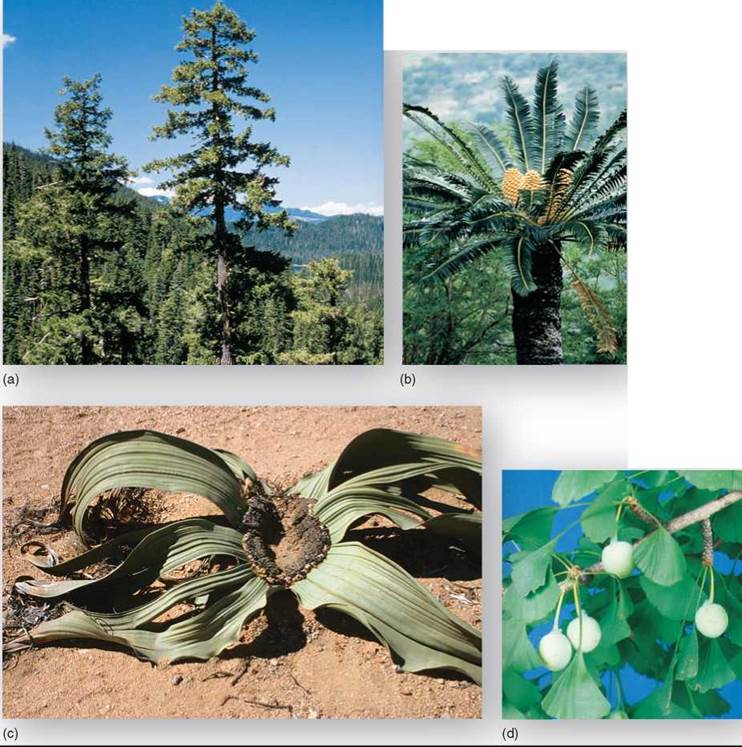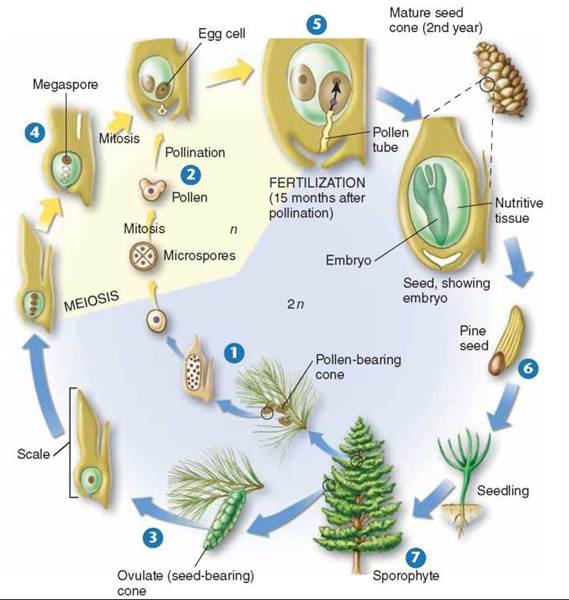THE LIVING WORLD
Unit Seven. Plant Life
32. Evolution of Plants
32.7. Gymnosperms

Four phyla constitute the gymnosperms (figure 32.13): the conifers (Coniferophyta), the cycads (Cycadophyta), the gnetophytes (Gnetophyta), and the ginkgo (Ginkgophyta). The conifers are the most familiar of the four phyla of gymnosperms and include pine, spruce, hemlock, cedar, redwood, yew, cypress, and fir trees, such as the Douglas firs in figure 32.13a. Conifers are trees that produce their seeds in cones. The seeds (ovules) of conifers develop on scales within the cones and are exposed at the time of pollination. Most of the conifers have needlelike leaves, an evolutionary adaptation for retarding water loss. Conifers are often found growing in moderately dry regions of the world, including the vast taiga forests of the northern latitudes. Many are very important as sources of timber and pulp.

Figure 32.13. Gymnosperms.
(a) These Douglas fir trees, a type of conifer, often occur in vast forests. (b) An African cycad, Encephalartos transvenosus, phylum Cycadophyta. The cycads have fernlike leaves and seed-forming cones, like the ones shown here. (c) Welwitschia mirabilis, phylum Gnetophyta, is found in the extremely dry deserts of southwestern Africa. In Welwitschia, two enormous, beltlike leaves grow from a circular zone of cell division that surrounds the apex of the carrot-shaped root. (d) Maidenhair tree, Ginkgo biloba, the only living representative of the phylum Ginkgophyta, a group of plants that was abundant 200 million years ago. Among living seed plants, only the cycads and ginkgo have swimming sperm.
There are about 600 living species of conifers. The tallest living vascular plant, the coastal sequoia (Sequoia sempervirens), found in coastal California and Oregon, is a conifer and reaches over 100 meters (328 ft). The biggest redwood, however, is the mountain sequoia redwood species (Sequoiadendron gigantea) of the Sierra Nevadas. The largest individual tree is nicknamed after General Sherman of the Civil War, and it stands more than 83 meters (274 ft) tall while measuring 31 meters (102 ft) around its base. Another much smaller type of conifer, the bristlecone pines in Nevada, may be the oldest trees in the world—about 5,000 years old.
The other three gymnosperm phyla are much less widespread. Cycads (figure 32.13b), the predominant land plant in the golden age of dinosaurs, the Jurassic period (213-144 million years ago), have short stems and palmlike leaves. They are still widespread throughout the tropics. The gnetophytes, phylum Gnetophyta, consist of only three kinds of plants, all unusual. One of them is perhaps the most bizarre of all plants, Wel- witschia, shown in figure 32.13c, which grows on the exposed sands of the harsh Namibian Desert of southwestern Africa. Welwitschia acts like a plant standing on its head! Its two beltlike, leathery leaves are generated continuously from their base, splitting as they grow out over the desert sands. There is only one living species of ginkgo, the maidenhair tree, which has fan-shaped leaves (shown in figure 32.13d) that are shed in the autumn. Because ginkgos are resistant to air pollution, they are commonly planted along city streets.
The fossil record indicates that members of the ginkgo phylum were once widely distributed, particularly in the Northern Hemisphere; today, only one living species, the maidenhair tree (Ginkgo biloba), remains. The reproductive structures of ginkgos are produced on separate trees. The fleshy outer coverings of the seeds of female ginkgo plants exude the foul smell of rancid butter caused by butyric and isobutyric acids. In many Asian countries, however, the seeds are considered a delicacy. In Western countries, because of the seed odor, male plants that are vegetatively propagated are preferred for cultivation.
The Life of a Gymnosperm
We will examine conifers as typical gymno- sperms. The conifer life cycle is illustrated in figure 32.14. Conifer trees form two kinds of cones. Seed cones 3 contain the female game-tophytes, with their egg cells; pollen cones 1 contain pollen grains. Conifer pollen grains 2 are small and light and are carried by the wind to seed cones. Because it is very unlikely that any particular pollen grain will succeed in being carried to a seed cone (the wind can take it anywhere), a great many pollen grains are produced to be sure that at least a few succeed in pollinating seed cones. For this reason, pollen grains are shed from their cones in huge quantities, often appearing as a sticky yellow layer on the surfaces of ponds and lakes—and even on windshields.

Figure 32.14. Life cycle of a conifer.
In all seed plants, the gametophyte generation is greatly reduced. In conifers such as pines, the relatively delicate pollen-bearing cones 1 contain microspores, which give rise to pollen grains 2, the male gametophytes. The familiar seed-bearing cones of pines 3 are much heavier and more substantial structures than the pollen-bearing cones. Two ovules, and ultimately two seeds, are borne on the upper surface of each scale, which contains the megaspores that give rise to the female gametophytes. After a pollen grain reaches a scale, it germinates, and a slender pollen tube grows toward the egg. When the pollen tube grows to the vicinity of the female gametophyte 4, sperm are released 5, fertilizing the egg and producing a zygote. The development of the zygote into an embryo takes place within the ovule, which matures into a seed 6. Eventually, the seed falls from the cone and germinates, the embryo resuming growth and becoming a new pine tree 7.
When a grain of pollen settles down on a scale of a female cone, a slender tube grows out of the pollen cell up into the scale, delivering the male gamete to the female gametophyte containing the egg, or ovum. Fertilization occurs when the sperm cell fuses with the egg 5, forming a zygote that develops into an embryo. This zygote is the beginning of the sporophyte generation. What happens next is the essential improvement in reproduction achieved by seed plants. Instead of the zygote growing immediately into an adult sporophyte—just as you grew directly into an adult from a fertilized zygote—the fertilized ovule forms a seed 6. The pine seed contains a sail-like structure that helps the seed to be carried by the wind. The seed can then be dispersed into new habitats. If conditions are favorable where the seed lands, it will germinate and begin to grow, forming a new sporophyte plant 7.
Key Learning Outcome 32.7. Gymnosperms are seed plants in which the ovules are not completely enclosed by diploid tissue at pollination. Gymnosperms do not have flowers.